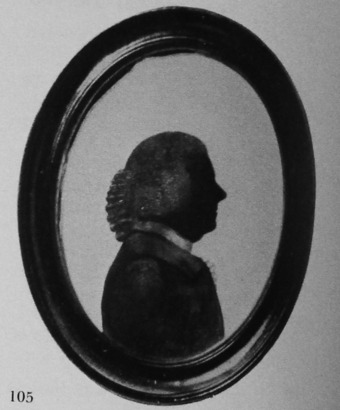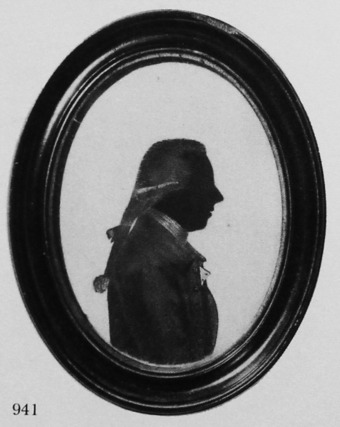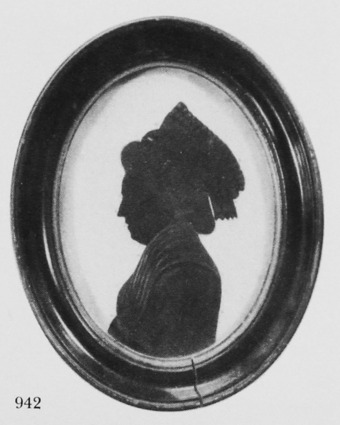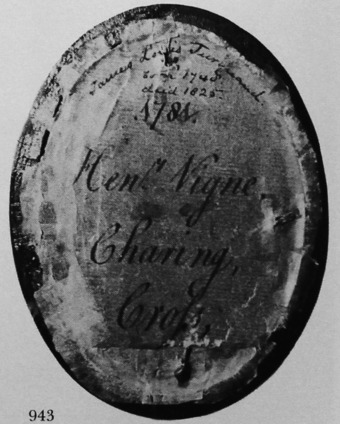Vigne, Henry George (McKechnie Section 2)
Not mentioned by previous writers on silhouettes but recorded as a miniaturist by Long and Foskett. According to the former, Vigne exhibited two miniatures at the Royal Academy, one in 1785 and another in 1787, from an address at 'Mr. Vigne's, Watchmaker, 2, Charing Cross' (shown below to have been the address of the profilist). Foskett suggests that he may have been the Henry Vigne who entered the Royal Academy Schools on 8 November 1782, aged seventeen on 'Jan 15 Last'. He was therefore born in 1765. Since the only authenticated profiles by him are dated 1781 and 1782, I believe that he painted the four known examples when he was only fifteen and sixteen years old, and painted no more silhouettes after entering the Schools. A minor miniaturist, Vigne was evidently able enough to achieve the inclusion of his work in exhibitions at the Royal Academy, and ceased to paint silhouettes after he had begun to win some recognition as a miniaturist.
Kent's London Directory states that one James Vigne and his family were living in 1789 at 2 Charing Cross. This address is of interest to collectors of silhouettes, for, in 1791, the numbering of the houses changed, and this house became 2 Strand, later for many years the home of John Field, who died there. In this directory reference, James Vigne is described as a watchmaker.
There is a reference in the notes of F. and G. B. Buckley (Victoria and Albert Museum, typescript collection) to an excerpt from The World (24 January 1788), which reads as follows: 'Mr. Henry George Vigne, miniature painter, died last week at his father's house, Charing Cross.' (The relevant issue of this newspaper is in the Burney collection at the British Museum.)
It is thus evident that Henry George Vigne predeceased his father James. It is possible that the family moved to Dublin after the loss of their son, and that it was Henry's sister Marianne whom the painter and miniaturist George Chinnery married in that city on 19 March 1799. Chinnery's wife is known to have been the daughter of a Dublin jeweller. He left her for fourteen years while he lived in India (in Madras and Calcutta), and completely abandoned her and her children in 1825, when he began working in Macao and Canton.
Four profiles by Vigne, the only authenticated examples of which I know, are illustrated in this book. Ail were taken in 1781-82. The sitters are two married couples of the Turquand family. Those of the older couple represent Paul Turquand (1715-1800) and his wife, Mrs Paul Turquand (1719-85); they are illustrated in Chapters Four and Six respectively. The latter profile is signed on the front 'H. Vigne fecit'. Of the same size, and similarly framed, are the profiles of Mr and Mrs James Louis Turquand (presumably the son and daughter-in-law of Mr and Mrs Paul Turquand), illustrated in this Section.
All four examples are well painted in tones of dark grey; some body colour was apparently used. The darkest tone is reserved for the face, and all details of clothing are carefully shown. The oval pieces of card on which the profiles are painted are larger than those used by most painters on paper working c. 1780, measuring 41/4 x 31/4 in. The profiles have no bust-line termination, but continue to the base of the card. The oval frames are of well turned ebonised wood, without the crenellated edge favoured by some other artists. The inner edges of the frames are not gilded.
There are handwritten inscriptions on the reverses of two of the four known silhouettes by Vigne. One is illustrated; the other (on the reverse of the profile of Mrs James Louis Turquand) reads `Heny Vigne delint, Charing Cross, 1782'.
Ills. 105, 168, 941-943
105 168

Paul Turquand
Silhouette by Henry G. Vigne, 1781-82.
costume dating points
The physical wig, in this case arranged in neat rolls.
The pre-1785 stock, with no bows.
The coat, with the small collar typical of the late 1770s. Turquand, an older man, was still wearing this now unfashionable type of coat and had not yet taken to the frock.
James Cartland collection
Chapter 6

Mrs Paul Turquand
Silhouette by Henry G. Vigne, 1781.
costume dating points
As an older woman, Mrs Turquand has not had her hair dressed in the height of fashion, and her cap is placed well down on her head.
Although this silhouette is dated 1781, Mrs. Turquand, as an older woman is wearing the small dormouse indoor cap of the 1770s. Note the cheek-wrappers.
The small handkerchief, typical of the 1770s, draped about the shoulders. A younger woman would have worn wither a buffon or a large handkerchief at this date.
James Cartland collection
SECTION TWO

James Louis Turquand
Silhouette painted on card in tones of dark grey
1781
4¼ x 3¼in./109 x 83mm.
Frame: oval, ebonised wood
Inscribed on the reverse (see 943).
The sitter, presumably the son of Paul Turquand (105), was born in 1748 and died in 1825. See 1349 for a silhouette of this sitter, as a much older man, taken in the studio of John Miers.
James Cartland collection

Mrs James Louis Turquand
Silhouette painted on card in tones dark grey
1782
4¼ x 3¼in./109 x 83mm.
Frame: oval, ebonised wood
Inscribed on the reverse, ‘Heny Vigne delint, Charing Cross, 1782’.
The wife of the sitter shown in 941, Mrs Turquand was born in 1746 and died in 1800.
James Cartland collection

Inscription on the reverse of a silhouette (941) painted by Henry G. Vigne.
James Cartland collection
